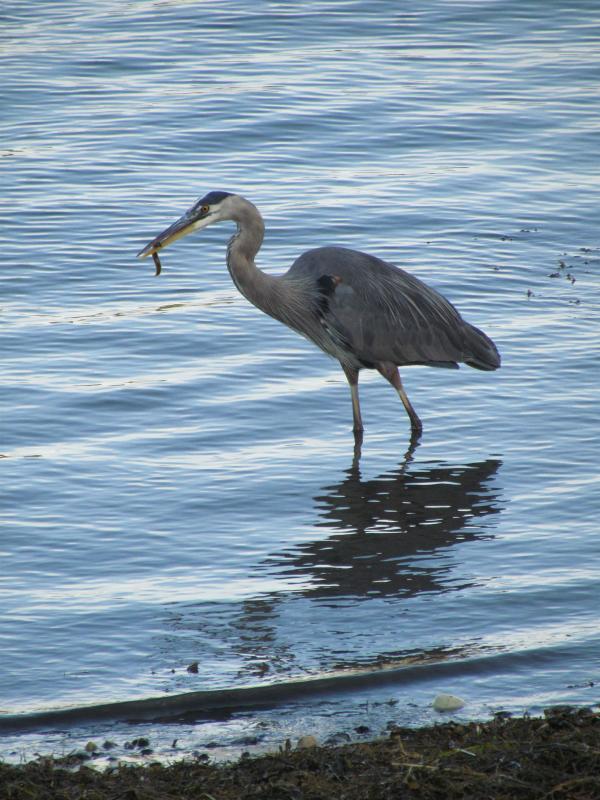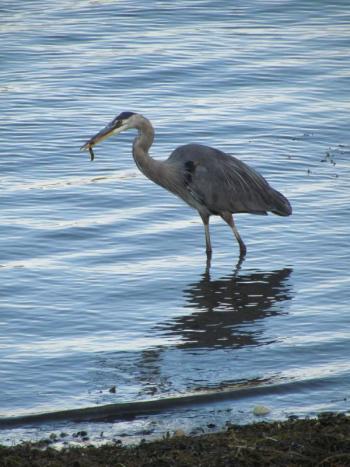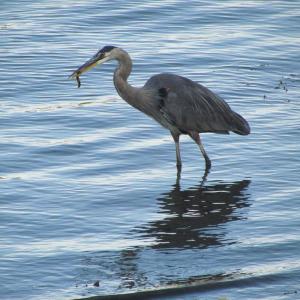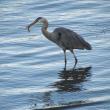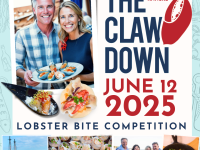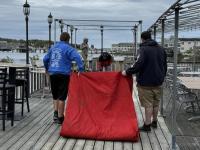What Do Great Blue Herons Eat?
Great blue herons are one of our largest birds and, perhaps because of their size, among the most familiar. We see them along our ocean shores, beside lakes, ponds, streams, and rivers, in muddy wetlands. Some may call them cranes; others, the less flattering sh*tpokes. There are more names, too. They are a bird that is hard to ignore.
Great blue herons occur across virtually the entire U.S. and southern Canada. They winter south to northern South America. Here in Maine they are distributed across the state in summer with a small number wintering along the southern Maine coast.
Given that we most often see great blue herons foraging in shallow water along shorelines, it’s easy to think of them as a species that eats nothing but small fish. And that is what they do most of the time in most places. But their widespread breeding range may be a clue to the amazing adaptability that’s evident by what they eat.
While small fish may be the norm by way of diet for great blue herons most of the time, this species will not hesitate to take a larger fish if the opportunity presents itself. In fact, great blue herons have occasionally choked to death when they captured and partially swallowed a fish that went beyond their limits. We have a video of a great blue heron we watched swallow a fairly large alewife down at the head of Pemaquid Harbor some years ago. The fish was alive when swallowed and can be seen in the video still flipping and struggling in the heron’s stomach for some time after it was ingested. Another time at a small pond in Chelsea, we were surprised to see a great blue heron working to subdue and swallow a large American eel that was not giving up easily.
We have read of great blue herons eating mice and voles and other small mammals in areas where they are abundant. In one study in the western U.S., great blue herons were feeding their nestlings more voles than anything else. We have recently seen photos of a great blue heron with a dead chipmunk in its bill.
Great blue herons will even catch and eat other birds. The Cornell Lab of Ornithology’s Birds of the World account includes photos of one killing and eating another bird in the heron family, a least bittern, which seemed to us surprisingly large to have become dinner for a great blue. Decades ago we were watching shorebirds at the famed May’s Point Pool in Montezuma National Wildlife Refuge in upstate New York. A great blue heron was sitting on a log while around it swarmed a group of rapidly foraging least sandpipers. After standing for many minutes appearing oblivious to the sandpipers, the heron suddenly looked down at them with interest. It was as if it had suddenly realized one of the birds could make a good meal. With a lightning-fast jab, the heron struck one of the closest of the sandpipers right in the back of the head. The sandpiper likely never knew what hit it and it was dead in seconds. Sadly, the heron spent the next twenty minutes trying to swallow the bird, but the outstretched wings made it too wide to go down. Eventually, the heron gave up and flew away.
Certainly the most dramatic great blue heron prey capture we ever saw and video recorded took place on a mid-winter visit to Venetian Gardens in central Florida. There while enjoying the sights of purple gallinules, white ibis, wood storks, and other birds, we happened upon a great blue heron that had just captured a large water snake. For more than half an hour we watched the drama unfold as the snake fought for its life. While the heron tried to work the snake into a position to begin swallowing it, the snake wound itself around the heron’s head and neck. Eventually the heron managed to get the snake off its head and subdued it with more thrashing and jabbing. It did eventually get the snake partially swallowed but even when just the tail was sticking out, that feisty snake tried to wrap it around the heron’s bill. The heron had to regurgitate the snake several times before it finally got it all the way down.
We have never since underestimated the adaptability and resilience of great blue herons!
Jeffrey V. Wells, Ph.D., is a Fellow of the Cornell Lab of Ornithology and Vice President of Boreal Conservation for National Audubon. Dr. Wells is one of the nation's leading bird experts and conservation biologists and author of the “Birder’s Conservation Handbook.” His grandfather, the late John Chase, was a columnist for the Boothbay Register for many years. Allison Childs Wells, formerly of the Cornell Lab of Ornithology, is a senior director at the Natural Resources Council of Maine, a nonprofit membership organization working statewide to protect the nature of Maine. Both are widely published natural history writers and are the authors of the popular books, “Maine’s Favorite Birds” (Tilbury House) and “Birds of Aruba, Bonaire, and Curaçao: A Site and Field Guide,” (Cornell University Press).
Event Date
Address
United States

